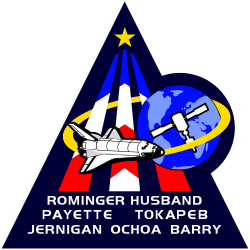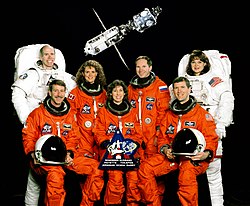STS-96
| STS-96 | |||||
 | |||||
| Uppdrag | 94 | ||||
|---|---|---|---|---|---|
| Rymdfärja | Discovery (26)[1] | ||||
| NSSDC-ID | 1999-030A[2] | ||||
| Färdens tid | 9 dagar, 19 timmar, 13 minuter, 59 sekunder | ||||
| Uppskjutning | |||||
| Startplats | Startplatta 39B vid Kennedy Space Center i Florida | ||||
| Start | 27 maj 1999 6:49 a.m. EDT | ||||
| Landning | |||||
| Landningsplats | KSC, Runway 15 | ||||
| Landning | 6 juni 1999 2:02:43 a.m. EDT | ||||
| Omloppsbana | |||||
| Varv | 153 st[3] | ||||
| Apogeum | 340 km | ||||
| Perigeum | 326 km | ||||
| Banlutning | 51,6° | ||||
| Sträcka | 6,0 miljoner km | ||||
| Rymdpromenad | |||||
| Antal | 1 st | ||||
| Total tid | 7 timmar, 55 minuter | ||||
| Dockning | |||||
| Rymdstation | ISS | ||||
| Dockning | 29 maj 1999, 04:23:55 UTC | ||||
| Dockningsport | PMA-2 (Unity, fram) | ||||
| Urdockning | 3 juni 1999, 22:39 UTC | ||||
| Tid dockad | 5 dagar, 18 timmar, 15 minuter | ||||
| Besättning | |||||
| Befälhavare | Kent Rominger (4) | ||||
| Pilot | Rick Husband (1) | ||||
| Uppdragsspecialister | Ellen Ochoa (3) Tamara E. Jernigan (5) Daniel T. Barry (2) Julie Payette (1) Kanada Valerij Tokarev (1) Ryssland | ||||
 | |||||
| Kronologi Rymdfärjeprogrammet | |||||
| |||||
STS-96 var en flygning i det amerikanska rymdfärjeprogrammet och den tjugosjätte i ordningen för rymdfärjan Discovery. Den sköts upp från Pad 39B vid Kennedy Space Center i Florida den 27 maj 1999. Efter nästan tio dagar i omloppsbana runt jorden återinträdde rymdfärjan i jordens atmosfär och landade vid Kennedy Space Center.
Flygningen gick till Internationella rymdstationen, ISS.
Flygningens mål var att leverera utrustning och förnödenheter till rymdstationen, detta gjorde man med hjälp av en Spacehab-modul placerad i rymdfärjans lastrum. Man levererade även en rysk Strelakran.
Rymdpromenader
Under flygningens enda rymdpromenad gjordes flera mindre installationer på utsidan av rymdstationen.
Statistik
| 1 | 30 maj 1999, 02:56 UTC | 30 maj 1999, 10:51 UTC | 7 tim, 55 min |
Besättning
- Kent Rominger (4), befälhavare
- Rick Husband (1), pilot
- Ellen Ochoa (3), uppdragsspecialist
- Tamara E. Jernigan (5), uppdragsspecialist
- Daniel T. Barry (2), uppdragsspecialist
- Julie Payette (1), uppdragsspecialist
- Valerij Tokarev (1), uppdragsspecialist
Väckningar
Under Geminiprogrammet började NASA spela musik för besättningar och sedan Apollo 15 har man varje "morgon" väckt besättningen med ett musikstycke, särskilt utvalt antingen för en enskild astronaut eller för de förhållanden som råder.
| Dag | Låt | Artist/Kompositör |
|---|---|---|
| 2 | "California Dreamin'" | Mamas and the Papas |
| 3 | "Danger Zone" | Kenny Loggins |
| 4 | Tema från Star Wars | Space Center Intermediate Band |
| 5 | "Morning Colors" | US Coast Guard Band |
| 6 | "Amarillo by Morning" | George Strait |
| 7 | "Exultate Jubilate" | Mozart |
| 9 | "Free Bird" | Lynyrd Skynyrd |
Se även
Referenser
- ^ NASA Space Shuttle Launch Archive Arkiverad 30 oktober 2007 hämtat från the Wayback Machine., läst 28 juli 2016.
- ^ ”NASA Space Science Data Coordinated Archive” (på engelska). NASA. https://nssdc.gsfc.nasa.gov/nmc/spacecraft/display.action?id=1999-030A. Läst 22 mars 2020.
- ^ Manned Astronautics - Figures & Facts Arkiverad 4 mars 2016 hämtat från the Wayback Machine., läst 28 juli 2016.
Externa länkar
 Wikimedia Commons har media som rör STS-96.
Wikimedia Commons har media som rör STS-96.
| ||||||||
| |||||||||||||||||||||||||||||||
| ||||||||||||||||||||||||||||||||
Media som används på denna webbplats
Designed by the crew members, this patch commemorates the first assembly flight to carry United States-built hardware for constructing the International Space Station (ISS). This flight's primary task is to assemble the cornerstone of the Space Station: the Node with the Functional Cargo Block (fgb). The rising sun symbolizes the dawning of a new era of international cooperation in space and the beginning of a new program: the International Space Station. The Earth scene outlines the countries of the Station Partners: the United States, Russia, those of the European Space Agency (ESA), Japan, and Canada. Along with the Pressurized Mating Adapters (PMA) and the Functional Cargo Block, the Node is shown in the final mated configuration while berthed to the Space Shuttle during the STS-88/2A mission. The Big Dipper Constellation points the way to the North Star, a guiding light for pioneers and explorers for generations. In the words of the crew, "These stars symbolize the efforts of everyone, including all the countries involved in the design and construction of the International Space Station, guiding us into the future."
Six NASA astronauts and a Russian cosmonaut take a break from training to pose for the STS-96 crew portrait. Astronaut Kent V. Rominger, mission commander, is at left on the front row. Astronaut Rick D. Husband, right, is pilot. The mission specialists are Ellen Ochoa (front center) and, from the left on the back row, Daniel T. Barry, Julie Payette, Valeriy I. Tokarev and Tamara Jernigan. Payette represents the Canadian Space Agency (CSA) and Tokarev is with the Russian Space Agency (RSA). The crew will perform the first station docking and will become the first visitors to the new International Space Station since its launch and start of orbital assembly last year. Discovery's launch date is now scheduled for May 20.
In this illustration, a SpaceX Crew Dragon spacecraft approaches the International Space Station for docking. NASA is partnering with Boeing and SpaceX to build a new generation of human-rated spacecraft capable of taking astronauts to the station and expanding research opportunities in orbit. SpaceX's upcoming Demo-1 flight test is part of NASA’s Commercial Crew Transportation Capability contract with the goal of returning human spaceflight launch capabilities to the United States.
Författare/Upphovsman: Pascal (Flickr user: pasukaru76), Licens: CC0
Vostok spacecraft replica at the Technik Museum Speyer, Germany.
Backdropped by a blue and white Earth, this close-up view features the Soyuz TMA-6 spacecraft approaching the International Space Station (ISS). Onboard the spacecraft are cosmonaut Sergei K. Krikalev, Expedition 11 commander representing Russia's Federal Space Agency; astronaut John L. Phillips, NASA ISS science officer and flight engineer; and European Space Agency (ESA) astronaut Roberto Vittori of Italy. The Soyuz linked to the Pirs Docking Compartment at 9:20 p.m. (CDT) on April 16, 2005 as the two spacecraft flew over eastern Asia. The docking followed Friday’s launch from the Baikonur Cosmodrome in Kazakhstan.
Designed by the crew members, this is the mission insignia for the STS-96 space flight, the second Space Shuttle mission dedicated to the assembly of the International Space Station (ISS). The crew patch highlights the major themes of the Station Program: Earth-directed research, the advancement of human space exploration, and international cooperation. The Space Shuttle Discovery is depicted shortly after reaching orbit as the crew prepares to carry out the first docking with the new Station. At this early stage in its construction, ISS consists of two modules: Zarya and Unity, shown orbiting Earth. The triangular shape of the patch represents building on the knowledge and experience of earlier missions, while the three vertical bars of the astronaut emblem point toward future human endeavors in space. The five-pointed star that tops the astronaut emblem in this depiction is symbolic of the five space agencies participating in the development of ISS: NASA, the Russian Space Agency, the European Space Agency, the National Space Development Agency of Japan, and the Canadian Space Agency. The blend of red, white, and blue is a tribute to the nationalities of the crew members who are from the United States, Canada, and Russia.
STS093 (S)-001 (Sept. 1998) --- The STS-93 mission patch, as designed by the five crew members. The STS-93 mission will carry the Advanced X-ray Astrophysics Facility (AXAF) into low Earth orbit initiating its planned five-year astronomy mission. AXAF is the third of NASA's great observatories, following the Hubble Space Telescope and the Compton Gamma Ray Observatory. AXAF will provide scientists an order-of-magnitude improvement over current capabilities at X-ray wavelengths. Observations of X-ray emissions from energetic galaxies and clusters, as well as black holes, promise to greatly expand current understanding of the origin and evolution of our universe. The STS-93 patch depicts AXAF separating from the Space Shuttle Columbia after a successful deployment. A spiral galaxy is shown in the background as a possible target for AXAF observations. The two flags represent the international crew, consisting of astronauts from both the United States and France. The NASA insignia design for Shuttle flights is reserved for use by the astronauts and for other official use as the NASA Administrator may authorize. Public availability has been approved only in the form of illustrations by the various news media. When and if there is any change in this policy, which we do not anticipate, it will be publicly announced.
Rotated and color enhanced version of original (ISS013-E-48788 (6 July 2006) --- The Space Shuttle Discovery approaches the International Space Station for docking but before the link-up occurred, the orbiter went through a series of inspection photos by station crew to inspect the vehicle for any damage to its Thermal Protection System. This was known as the Rendezvous Pitch Maneuver and was implemented after the Columbia Disaster in 2003. The Leonardo Multipurpose Logistics Module can be seen in the shuttle's cargo bay. Discovery docked at the station's Pressurized Mating Adapter 2 at 9:52 a.m. CDT, July 6, 2006.)











